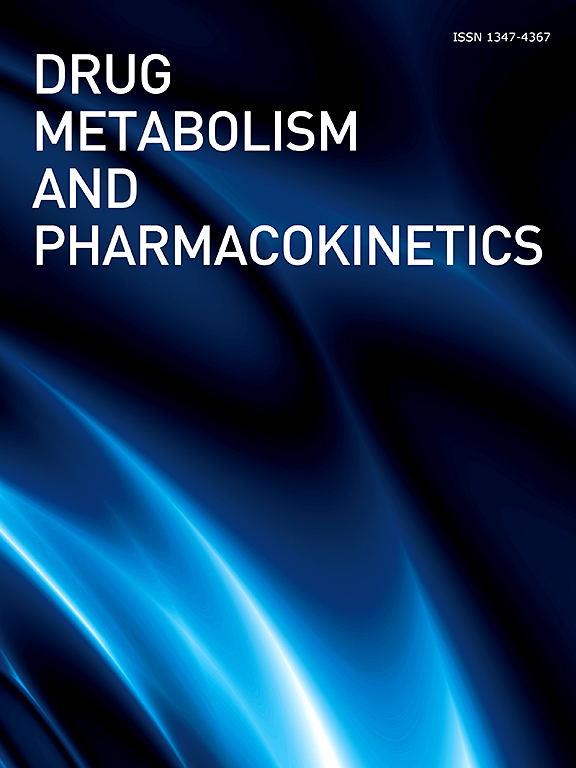Buffer compositions strongly impact the in vitro assessment of CYP fraction metabolized using human liver microsomes or expressed isoenzymes
IF 2.7
4区 医学
Q2 PHARMACOLOGY & PHARMACY
引用次数: 0
Abstract
We systematically evaluated the effects of different buffer compositions on the activities of cytochrome P450 (CYP)1A2, CYP2A6, CYP2B6, CYP2C8, CYP2C9, CYP2C19, CYP2D6, and CYP3A in human liver microsomes and in recombinant human CYP expression systems using the in vitro cocktail method. The activities of all CYP isoenzymes varied depending on the buffer conditions, particularly the activity of CYP1A2, which varied by 27.0-fold in phosphate buffer and HEPES or Tris-HCl buffer. The difference in the metabolic activities of CYP2D6 and CYP3A4 was smaller but significant, showing values about 2.0- and 3.0-fold higher in phosphate buffer than in HEPES or Tris-HCl buffer. A similar trend was observed for recombinant human CYP3A4/5. In contrast, the metabolic activities of CYP2A6 and CYP2B6 in phosphate buffer decreased by less than half as the phosphate concentration was increased. Changes in the metabolic activity of multiple CYP isoenzymes in buffers with different compositions suggest that the fraction metabolized (fm) evaluated in vitro differs depending on the experimental conditions. Specifically, the previously reported fm values of CYP1A2, CYP2B6, CYP2D6, and CYP3A in phosphate buffer may be overestimated. When evaluating the fm of these isoenzymes, we recommend conducting experiments under multiple buffer conditions.
缓冲成分强烈影响体外评估使用人肝微粒体或表达的同工酶代谢的CYP部分
我们采用体外鸡尾酒法系统地评估了不同缓冲液成分对人肝微粒体和重组人CYP表达系统中细胞色素P450 (CYP)1A2、CYP2A6、CYP2B6、CYP2C8、CYP2C9、CYP2C19、CYP2D6和CYP3A活性的影响。所有CYP同工酶的活性随缓冲液条件的不同而变化,特别是CYP1A2的活性,在磷酸盐缓冲液和HEPES或Tris-HCl缓冲液中变化27.0倍。CYP2D6和CYP3A4的代谢活性差异较小,但具有显著性,在磷酸盐缓冲液中比HEPES或Tris-HCl缓冲液中分别高出2.0倍和3.0倍。重组人CYP3A4/5也有类似的趋势。相比之下,随着磷酸盐浓度的增加,磷酸盐缓冲液中CYP2A6和CYP2B6的代谢活性下降不到一半。不同成分缓冲液中多种CYP同工酶代谢活性的变化表明,体外评估的代谢分数(fm)因实验条件而异。具体来说,先前报道的磷酸缓冲液中CYP1A2、CYP2B6、CYP2D6和CYP3A的fm值可能被高估了。当评估这些同工酶的fm时,我们建议在多种缓冲条件下进行实验。
本文章由计算机程序翻译,如有差异,请以英文原文为准。
求助全文
约1分钟内获得全文
求助全文
来源期刊
CiteScore
4.80
自引率
9.50%
发文量
50
审稿时长
69 days
期刊介绍:
DMPK publishes original and innovative scientific papers that address topics broadly related to xenobiotics. The term xenobiotic includes medicinal as well as environmental and agricultural chemicals and macromolecules. The journal is organized into sections as follows:
- Drug metabolism / Biotransformation
- Pharmacokinetics and pharmacodynamics
- Toxicokinetics and toxicodynamics
- Drug-drug interaction / Drug-food interaction
- Mechanism of drug absorption and disposition (including transporter)
- Drug delivery system
- Clinical pharmacy and pharmacology
- Analytical method
- Factors affecting drug metabolism and transport
- Expression of genes for drug-metabolizing enzymes and transporters
- Pharmacogenetics and pharmacogenomics
- Pharmacoepidemiology.

 求助内容:
求助内容: 应助结果提醒方式:
应助结果提醒方式:


